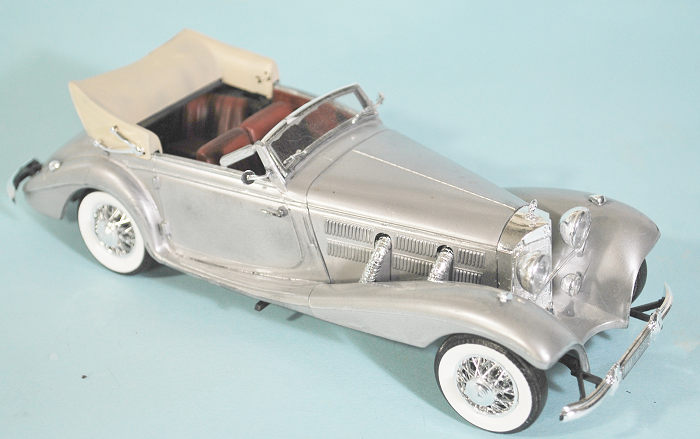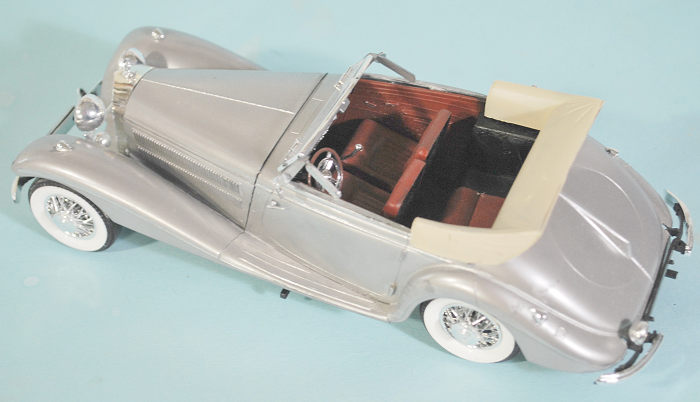
| KIT #: | 8202 |
| PRICE: | $35.00 'used' |
| DECALS: | None |
| REVIEWER: | Tom Cleaver |
| NOTES: |

| HISTORY |
Introduced at the 1936 Paris Motor Show, the Friedrich Geiger designed 540K was a development of the 500K, itself a development of the famed SSK. It was available as a both a two- and four-seat cabriolet, four seater coupé or seven seater limousine - with armored sides and armored glass - and was one of the largest cars of its time. The 540K retailed for 28,000 Reichsmarks(approximately $230,000 in 2024) in 1936.
 The
straight-8 engine of the 500K was enlarged in displacement to 5,401 cubic
centimeters (329.6 cu in). It was fed by twin pressurized updraft
carburetors, developing 115 hp. The attached Roots supercharger could either
be engaged manually for short periods, or automatically when the accelerator
was pushed fully to the floor. This increased power to 180 hp, giving a top
speed of 170 kilometers per hour (110 mph).
The
straight-8 engine of the 500K was enlarged in displacement to 5,401 cubic
centimeters (329.6 cu in). It was fed by twin pressurized updraft
carburetors, developing 115 hp. The attached Roots supercharger could either
be engaged manually for short periods, or automatically when the accelerator
was pushed fully to the floor. This increased power to 180 hp, giving a top
speed of 170 kilometers per hour (110 mph).
The 540K had the same chassis layout as the 500K, but it was significantly lightened by replacing the girder-like frame of the 500K with oval-section tubes. The supercharged 540K was justifiably held to be one of the greatest performance automobiles in the world, offering a state-of-the-art, competition-inspired chassis and an especially potent engine that “wailed like a banshee” with the blower engaged.
It was favored by wealthy enthusiasts on both sides of the Atlantic. Owners included Jack L. Warner, head of Warner Brothers film studios. To this day surviving cars are highly favored by enthusiasts for their driving ability, as well as for the beauty of the coachwork, built by the factory works at Sindelfingen, often accented by large Bosch headlights and by the trademark flamboyant chromed side exhaust emerging through the hood.
 Mercedes-Benz
produced the convertible cabriolet bodies for the 540 K in three series,
following the steady evolution of worldwide automotive design during the
1930s. The first was a short- lived design, shared with the last examples of
the 500 K, featuring long, very subtly skirted front fenders. It was
succeeded by a more streamlined design with somewhat higher doors and a low
windshield, then finally by a third-series version.
Mercedes-Benz
produced the convertible cabriolet bodies for the 540 K in three series,
following the steady evolution of worldwide automotive design during the
1930s. The first was a short- lived design, shared with the last examples of
the 500 K, featuring long, very subtly skirted front fenders. It was
succeeded by a more streamlined design with somewhat higher doors and a low
windshield, then finally by a third-series version.
As usual with Mercedes cars of this period the Sindelfingen factory provided in-house coach work, and employed 1,500 people to create the 540K, thus allowing for a great deal of owner customization; only 70 chassis were ever bodied by independent builders.
With the outbreak of World War II, the proposed further boring-out of the engine to 5,800 cubic centimeters for a 580K was aborted. Chassis production ceased in 1940, with the final two being completed that year, and earlier chassis were still being bodied at a steady rate during 1940, with smaller numbers being completed in the 1941–1943 period.
| THE KIT |
This kit is a second-series 540K, with the high doors and low windshield. It is another of the Monogram Classics from the 1960s. The kit was discovered at my LHS and immediately snapped up.
| CONSTRUCTION |
 As with
the Duesenberg, this model was assembled using C-A glue, since the plastic
didn’t take to modern “hot” glues. Before assembly, I painted the model. I
used Mr Color C-42 “Mahogany” lacquer acrylic for the leather interior and
C-45 “Sail Color” for the convertible top. The body was painted with Tamiya
LP-70 “Gloss Aluminum.” The chrome strips on the body were done with a
Molotow “Liquid Chrome” pen; I have to say this pen is incredible, because
it is the only paint I have found that matches the chrome plastic parts.
As with
the Duesenberg, this model was assembled using C-A glue, since the plastic
didn’t take to modern “hot” glues. Before assembly, I painted the model. I
used Mr Color C-42 “Mahogany” lacquer acrylic for the leather interior and
C-45 “Sail Color” for the convertible top. The body was painted with Tamiya
LP-70 “Gloss Aluminum.” The chrome strips on the body were done with a
Molotow “Liquid Chrome” pen; I have to say this pen is incredible, because
it is the only paint I have found that matches the chrome plastic parts.
Assembly was “adventurous,” since the kit parts have “60s fit” but I was able to get everything together and get all four wheels to touch ground.
| CONCLUSIONS |
This is an excellent kit for its time, and results in a model that has gotten compliments from two recent visitors to Le Chateau du Chat who aren’t modelers. Another in the series “Cars I Would Buy If I Won The Mega Millions Lottery.”
Review kit courtesy of all you book buyers.
6
June 2024
Copyright ModelingMadness.com. All rights reserved. No
reproduction in part or in whole without express permission.
If you would like your product reviewed fairly and fairly quickly, please
contact the editor or see other details in the
Note to
Contributors.